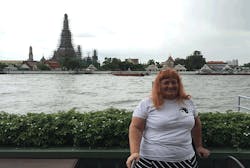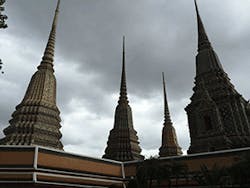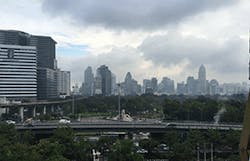Dateline Thailand: A Bucket List Trip Is Even More Amazing than Expected
Two years ago, a co-worker was invited by the Thailand Board of Investment (BOI) to visit that country and learn about U.S. investment. She visited several parts of the country and a number of businesses. To say that I was jealous is to put it mildly. I was nearly insane with jealousy.
You see, Thailand is on the top of my travel bucket list. My list is relatively short: Thailand, Cambodia, Vietnam, Bali and Africa (I’ve been fortunate to already have visited Europe). While I wouldn’t turn down a trip to another country, those four countries and one continent are my biggies. Years ago, a friend and I planned a trip that included the four Asian countries, but then I found my house and my choice was the house or the trip. I chose the house.
My friend recently went on the trip we had planned, after waiting 10 years for me to save the money to go. But, like many homeowners, there’s always something to fix or upgrade in my house, so my travel money disappeared as quickly as I saved it. I figured it would be another 10 years – at least – before I could go.
And then, joy of joys, BOI reached out to my co-worker again, about another trip. This time, she was unable to go. Others on her staff were unable to go. So I made the ultimate sacrifice (ahem!) and offered to go in her place.
I knew that Thailand would be amazing. I had no idea how amazing.
I’ll be writing about some of my experiences visiting facilities in the automotive and aerospace industries in the next couple of weeks, and probably will share some of my personal photos from sightseeing with you. But no matter what I say or what photos I include, nothing comes close to the full-on assault to the senses (in a good way) of my trip to Thailand.
“khaawp khoon kha/khrap” (Thank You)
My research about the country stemmed from some travel books, anecdotes from friends who had been there and the song “One Night in Bangkok.” None of it prepared me for what I found or for what I learned about myself.
The first thing I learned is to be grateful, something the Thai people have turned into an art form.
There is one phrase I try to learn in the native language of any country I visit. That phrase is “thank you.” A “thank you” goes a long way. Even if I don’t learn anything else, “thank you” has served me well over the years. Thailand was no different.
Except in Thailand, phrases can change, depending on if you’re speaking to a man or woman (or lady boy). Khaawp khoon kha is the phonetic spelling of “thank you” when said to a female. It generally includes placing the hands as if in prayer and a slight bow of the head. When speaking to a man, “khaawp khoon khrap” is how you say thank you.
“sa wat dee” (Hello/Good-Bye)
“Sa wat dee” is the phonetic spelling of an interchangeable “hello,” “good-bye,” “good morning” and “good evening.” Walk up to any Thai person – a hotel employee, a restaurant employee, a shopkeeper, a street vendor, a worker at a temple, the CEO of a Thai company or the director-general of the Thailand Ministry of Foreign Affairs – and you will be greeted with “sa wat dee” and that person’s full attention. Every Thai person I met made me feel as if I was the most important person he or she was going to speak with that day. For those few seconds, I had his or her undivided attention. Again, it only takes a minute to make someone feel special and valued, but I rarely take that moment to do it. Being in Thailand reminded me to live in the moment, and to not always be looking for the next person to talk to.
Everyone who has been to Thailand says the same thing: The Thai people are kind. It’s true. Despite traffic that makes any U.S. city look bucolic, a sometimes daily struggle to survive, financial pressure from Asia’s economic issues, a recent military coup and subsequent new government, an ailing king and queen, overcrowding in cities, pollution and devalued currency, the Thai people manage to be polite, kind and funny. They love to laugh. They love to joke. They love to share their food and culture with others. They are proud of their country and proud of their heritage.
This national pride extends to the business community, which is proud of what it has accomplished in a relatively short period of time. While the government officials and business leaders I met agreed that Thailand was a “developing” country rather than a “developed” one, the strides it has made in the past 20 years or so have been remarkable.
The education system is greatly improved; the economic base is shifting from agriculture and hospitality to manufacturing and even technology; foreign investment grows each year; the standard of living for many people has improved; the nation is investing in much-infrastructure improvements; and the unemployment rate is low.
“khaaw hai cho:hk dee” (Good Luck to You)
Director-General Chutintorn Sam Gongsakdi, of the Department of International Economic Affairs, Ministry of Foreign Affairs, proudly told our group of journalists that Thailand has been asked to chair the Group of 77 at the United Nations. The Group of 77, which actually includes 134 countries, is a loose coalition of developing nations, designed to promote its members’ collective economic interests and create an enhanced joint negotiating capacity in the United Nations.
While I was in Thailand, the news stations were reporting on the Trans-Pacific Partnership (TPP), a trade agreement between twelve countries – the United States, Australia, Mexico, Canada, Japan, Brunei, Chile, New Zealand, Singapore, Malaysia, Peru and Vietnam – that was signed Oct. 5. The TPP seeks to lower trade barriers such as tariffs, establish a common framework for intellectual property, enforce standards for labor and environmental laws and establish an investor-state dispute settlement mechanism.
Gongsakdi called Thailand’s participation as a member of TPP an “aspirational goal,” and said that the country’s parliament still had work to do to lay the groundwork for participation in TPP.
“The future is bright, but it needs work,” said Gongsakdi.
However, Thailand is part of the ASEAN Economic Community (AEC), an effort to achieve regional economic integration by the end of 2015. AEC envisages a single market and production base, a highly competitive economic region, a region of equitable economic development and a region fully integrated into the global economy.
The AEC areas of cooperation include human resources development and capacity building; recognition of professional qualifications; closer consultation on macroeconomic and financial policies; trade financing measures; enhanced infrastructure and communications connectivity; development of electronic transactions through e-ASEAN; integrating industries across the region to promote regional sourcing; and enhancing private sector involvement for the building of the AEC. In short, the AEC will transform ASEAN into a region with free movement of goods, services, investment, skilled labor and freer flow of capital, much like NAFTA in North America.
“This is where the growth is going to be,” said Gongsakdi of Thailand. “This is the golden land.”
Stay tuned for more Dateline Thailand articles in the next few weeks. The articles will focus on doing business in Thailand, with topics ranging from investment and recruitment of workers to worker safety and health. Some of the companies featured will include Triumph, Mitsubishi Motors, Senior Aerospace, Thai Airways and the Pan-Am International Training Center.
“Laaeo phohp gan mai.” (Until we meet again.)
About the Author
Sandy Smith Blog
Content Director
Sandy Smith is content director of EHS Today. She has been writing about occupational safety and health and environmental issues since 1990. She has been interviewed about occupational safety and health for national business publications,documentaries and television programs, has served as a panelist on roundtables, has provided the keynote address for occupational safety and health conferences and has won national and international awards for her articles.



